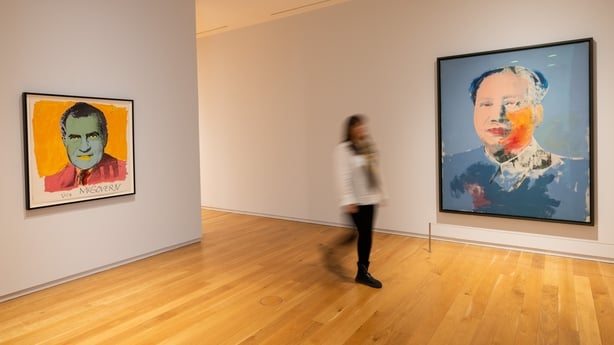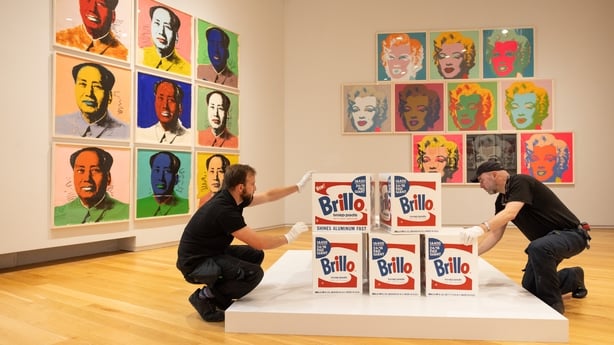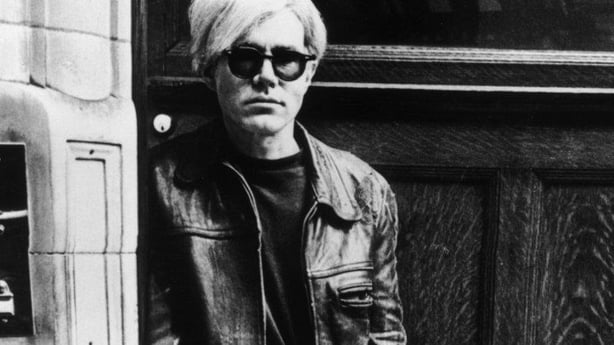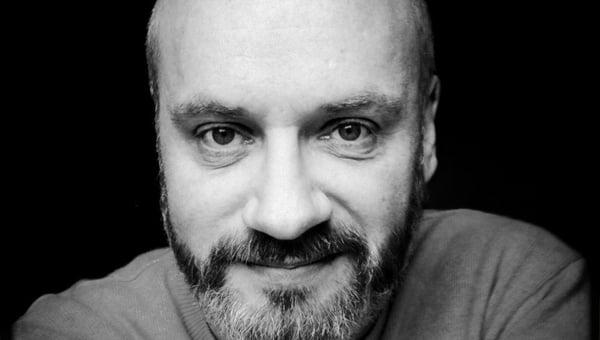Barbara Dawson, Director of the Hugh Lane Gallery, and Michael Dempsey, Head of Exhibitions, introduce Andy Warhol Three Times Out, a major new exhibition at the Hugh Lane celebrating the artistic vision of one of the most important and recognisable artists of the 20th century.
In the three and a half decades since Andy Warhol died in a New York hospital, there have been significant changes in how we view his work.
Ever the enigma, he was a loner in life and yet he was at the fulcrum of American society and culture. Through a time of sweeping societal transition, he embraced the ubiquitous presence of mass media by appropriating and reproducing imagery from advertisements, news events and the cult of celebrity in his artwork. Our curatorial selection celebrates Warhol's profuse productivity and diverse subject matter in 10 key sections: "Early Drawings"; "Good Business is the Best Art"; "The Surface of Things"; "Performing Andy Warhola"; "Endless Silver"; "History Repeats"; "Symbols and Discontent"; "Death in America"; "Collaborations"; and "EPI Up Tight".
We need your consent to load this rte-player contentWe use rte-player to manage extra content that can set cookies on your device and collect data about your activity. Please review their details and accept them to load the content.Manage Preferences
Listen: Andy Warhol in Dublin - Barbara Dawson talks to Brendan O'Connor
At the heart of Three Times Out lies the artist’s deep-rooted engagement with collaboration, mass media and experimentation: from Warhol’s first illustrations with his mother, Julia, and early colouring parties with friends to his collaborations with actors, filmmakers, musicians, bohemian denizens and artists. In the 1960s this cross-contamination formed the nexus of the Silver Factory’s identity. Out of these collaborations came his innovative films Sleep, Empire, Kiss and Outer and Inner Space, challenging traditional notions of narrative and embracing the freedom of non-linear storytelling. He also embarked on his enduring engagement with the cult of celebrity, beginning with his Marilyn portraits and consumer capitalism. The 1970s saw him develop multiple postmodern strategies coined in the phrase "Good business is the best art".

By the 1980s, with his identity and artist brand firmly established, he returned to painting inspired by his collaborations with Francesco Clemente, Keith Haring and JeanMichel Basquiat – an experiment that continued with Basquiat, their unique styles locked together in combative discord. As this exhibition reveals, Warhol also collaborated with the photographer and artist Peter Beard in a series of collages. Their art merged through a dialectic of styles in Warhol’s recognisable pop technique juxtaposed with Beard’s raw and unpredictable approach. Francis Bacon enters the scene though this friendship: Warhol and Bacon first met in Paris in 1974. Warhol was candid about his admiration of Bacon, and Bacon saw in Warhol a new vision in fine-art practice.
We need your consent to load this rte-player contentWe use rte-player to manage extra content that can set cookies on your device and collect data about your activity. Please review their details and accept them to load the content.Manage Preferences
Listen: Andy Warhol Three Times Out reviewed on RTÉ Arena
This exhibition displays a unique section focusing on work of Peter Beard. Drawn from the collections of the Estate of Peter Beard, Andy Warhol Museum and Francis Bacon Archive at Hugh Lane Gallery, it discloses the creative relationship Beard had with both Andy Warhol and Francis Bacon, thus activating a dialogue between these two titans of the 20th century. Both Warhol and Bacon were attracted to the bite of Beard's photography – a magnificent and pitiless testimony to the brutal forces of life, death and decomposition. Warhol’s ability to interrogate the psychological allure of gruesome images churned out by mass media, and to challenge the complacency with which they are received, finds expression in his "Death and Disaster" series, originally called "Death in America". Through these aesthetically beautiful images he presents us with a disquieting portrayal of the underbelly of American society. Warhol’s alter egos expressed in many self-portrait works, much like his multiples, were part of his strategy to dispel the myth of the subjective artist rather than compound it. He saw identity as a construct and as such invented multiple public and artistic personae through his visage and style.

final checks to Andy Warhol Three Times Out at the Hugh Lane
Similarly to Francis Bacon, he created an enigmatic public persona that became an integral part of his artistic identity. However, perhaps their aims diverge as Warhol’s camping (or "swishing", as it was called in the 1950s) fits into the overall Warholian project of "Queering" the established modernist narrative of the heroic male genius that prevailed in the Western canon. He presented himself as a blank canvas onto which others projected their ideas and desires, perfecting a detached and impersonal demeanour for public consumption. Fully appreciative of the transformative impact of emerging mass media technologies, Warhol’s exploration of film, TV and publishing production was revolutionary. Today as we navigate the age of social media and surveillance capitalism, we cannot overlook his prescient vision, and his influence is undeniable in the ever-evolving landscape of social media platforms. Individuals construct and perform their identities untiringly, mirroring his fascination with the commodification of self.

Andy Warhol Three Times Out also reveals a narrative of Warhol’s concentration on perennial themes – the fragility of the individual, the tragedy of existence, the passing of time, and his perpetual consciousness of the presence of death. Vicissitudes of societal perspectives make it possible to interpret the artist Andy Warhol and his work from changed moral viewpoints through the distant mirror of repeated histories. We witness his iconic images in a historical repetition that seems to govern our lives and values – a testament to his enduring significance. A voyeur, an avant-garde artist, a partygoer and a church attender, Warhol the introvert, the supreme socialite, remains an enigma. Andy Warhol Three Times Out underlines how Andrew Warhola the outsider altered how we look at the world in order to realise his place in it.
Three decades on, who was Andy Warhol – the guise of Drella, the genius, the court fool …? Warhol would have simply answered "YES".
Andy Warhol Three Times Out is at the Hugh Lane Gallery, Dublin until January 28th 2024 - find out more here. Pics:Naoise Culhane
